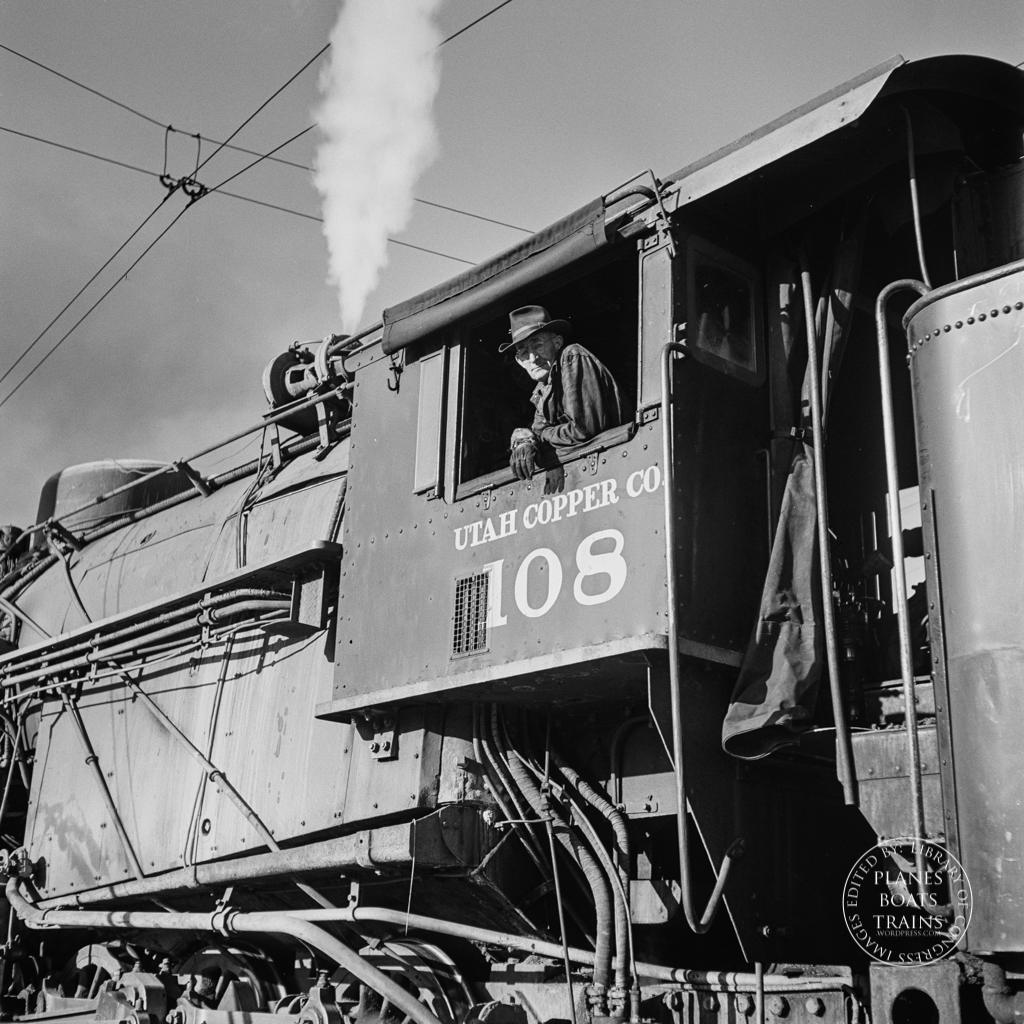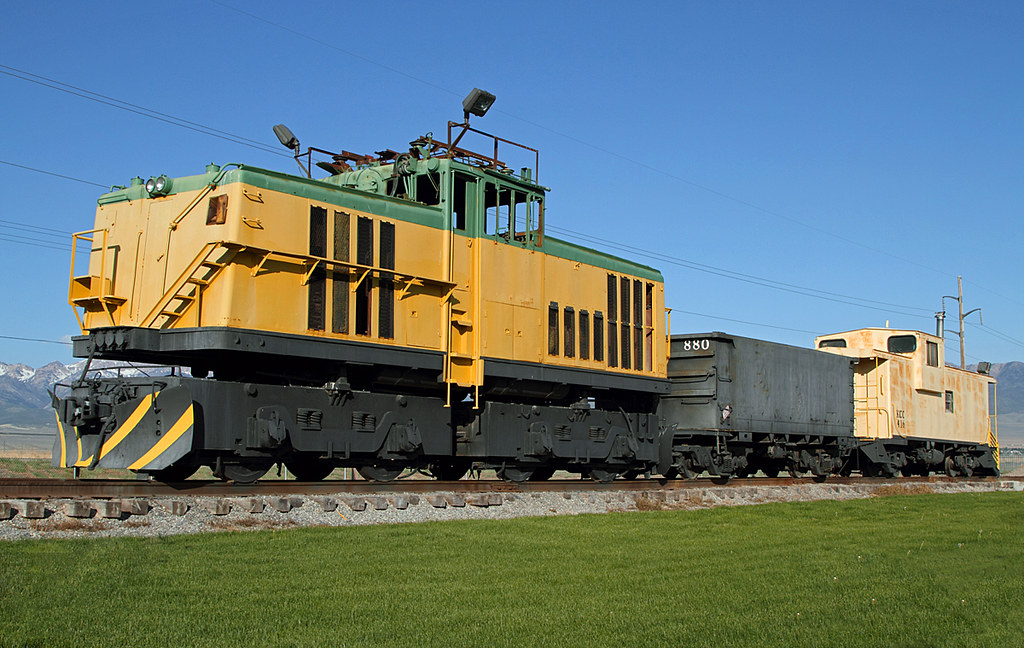-----
 |
| UCC Articulated No. 108 under the wire at Bingham Canyon, 1942. (Andreas Feininger) |
 |
| An unidentified Kennecott/UCC Articulated at Markham Gulch, looking south. (Don Strack) |
The Bingham and Garfield Railway opened in 1911 adjacent to the D&RG's Bingham and Garfield Beach branches. Its initial roster, dated one year later, sported 8 simple and 3 compound steam locomotives, then expanded to 4 compound engines just a year later. Most of these locomotives were massive articulated-types, built for brute-force dragging of long ore loads from the mines to mills, assisted by smaller switchers. It was a dramatic sight to have a large articulated precariously elevated over a large canyon, 90 ore cars behind it, as it ponderously thundered towards the top of the mine on a grueling 2.5% (1 in 2.5) grade.
Looking to save on operating costs, UCC looked to electrification to haul more product for less. The logic here was sound: electricity had as much instant torque as a steam locomotive, but could apply power more consistently with no loss of steam pressure. Starting in 1924, the railway trialed two electric locomotives serving the mill car dumpers, numbered 1000 and 1001. Three years later, in 1927, steam and electric were trialed together to see if the new locomotives had mainline potential. After favorable outcomes, an order of 42 electric locomotives were delivered between late 1927 and 1929. Some steam locomotives were retained as backup power, while others were sold to Nevada mining interests.
 |
| Kennecott (Ex-UCC) No. 709, part of the original order of 42 locomotives, at Copperton Yard, 1972 (Don Strack) |
The 42 electric locomotives were built by General Electric between 1927 (as trialed) and 1929, with the first production locomotive arriving in June 1928. Unfortunately, this locomotive (UCC 701) was wrecked in transit and never operated, being scrapped in September that same year when UCC 702 was delivered. These initial 80-ton locomotives were built to a steeplecab pattern and ran on both overhead trolley wire (750V DC) and battery power (225V DC), generating 33,000lbs of tractive effort. Their batteries could give them 6 extra hours of off-wire operating time. Locomotives 700, 702, 703 and 724 were the only battery-powered locomotives, while the rest of the order were heavier all-wired electrics, generating an extra 2,000lbs of tractive effort. Three locomotives (737, 740 and 741) were sold as Bingham & Garfield Railway locomotives for use in car-dump service, but later interchanged with other common-carrier railroads.
 |
| An animated demonstration of the overhead rigging at work on Kennecott No. 760, taken from "Desert Empire", 1948 (Public Domain) |
An operational marvel of the Utah Copper Co. Railroad was their portable overhead, also known as the "cable reel". This, and the batteries on the four aforementioned engines, were used in places in the Bingham Mine whenever lines needed to be relocated and more permanent overhead wire wasn't available. Mounted on rickety-looking, "tin-shed" pylons, the stands rested on the dirt that also supported the tracks and ran off the main electrical supply, feeding a trolley wire that rested on the side of the line. To run on the "cable reel", the locomotives featured a swinging pneumatic trolley pole that raised and pushed against the wire to maintain contact. In places that featured parallel overhead, the locomotives had a traditional center-blade pantograph.
 |
| Bingham & Garfield 737 moves past an articulated 0-8-8-0 with empty ore cars, note the numerous trestles and zig- zagging railway lines going up and down the mine's sides. (Don Strack) |
Utah Copper Co. was bought by the Alaskan-based Kennecott Company in 1936, with the railroad being renamed to the Kennecott Utah Copper Rail Line, but the locals just called it the "Kennecott". By this point, Bingham Canyon Mine was (and still is) the largest open-pit mine in the world and eventually accounted for over 19 million tons of copper ore shifted worldwide. Kennecott built on more electric investment by ordering 19 more 85-ton electrics from General Electric in 1937. These weighed 75 tons, but had to be re-ballasted for better weight adhesion. They were later joined in 1942 by new 92-ton electrics, which generated an earthshaking 50,300lbs tractive effort.
 |
| Kennecott 401 and 403 at Magna mill on December 8, 1978 (James Belmont) |
The largest and strongest Kennecott locomotives arrived after World War II, starting in 1947 with Kennecott Nos. 401-407. These locomotives ran on both 3000V DC on the mainline and 750V DC in the yards, and their powerful traction motors generated 3200 horsepower and 62,500lbs tractive effort. Their main job was to power the 18 28-mile trips made daily between the mines and Copperton yard, racking up 50,000 annual miles each. They were so massive, the stepladders on their front preceded the massive Caterpillar dump trucks that also featured a front staircase. The final orders were placed in 1952 and 1955 for 8 more 125-ton locomotives, Nos. 766-773. These made 57,700lbs tractive effort, but were no less bigger than the 1947 order.
Kennecott continued operating electric locomotives at the Bingham Canyon Mine until 1979, when new EMD diesels were brought in to replace the aging electrics. Electric power was cut off starting in January, with the last electric infrastructure gone by that September. By the mid 1980s, many former Kennecott electrics found homes (or their end) in the Western Railroad Museum, Portola, California, (Nos. 700, 771, & 407), the Promontory Chapter of the National Rail Historical Society, UT, (402, 759, 761, 775, 776, and 777, all of which were scrapped in 1984), Boone Valley Historical Society, Indiana, (Nos. 408, 409, 702 & 703), and The Puget Sound Railway Historical Society (724, which has since been scrapped due to air brake problems and general disrepair).
 |
| Kennecott No. 402, on display at the Oquirrh Mining Museum in Tooele, UT. (Jeff Terry) |
The Kennecott Mining Railroad continues operation under Australian ownership using diesel power, and still produces an unreasonable amount of copper every year. Just don't drink the local water.
-----

No comments:
Post a Comment